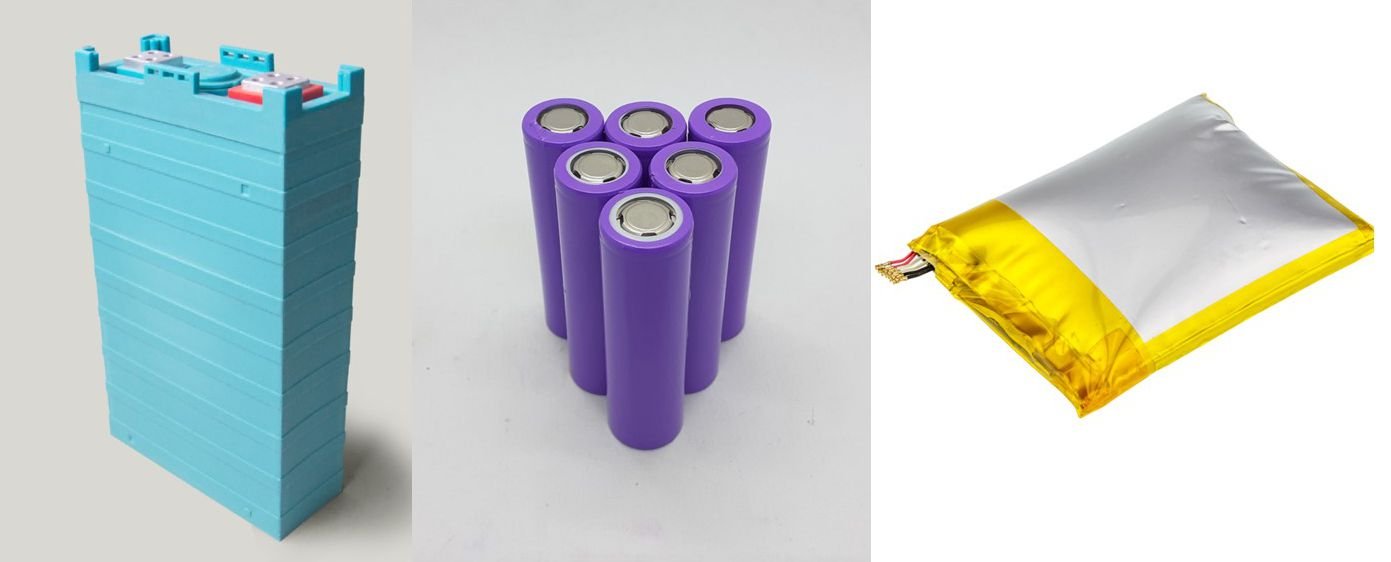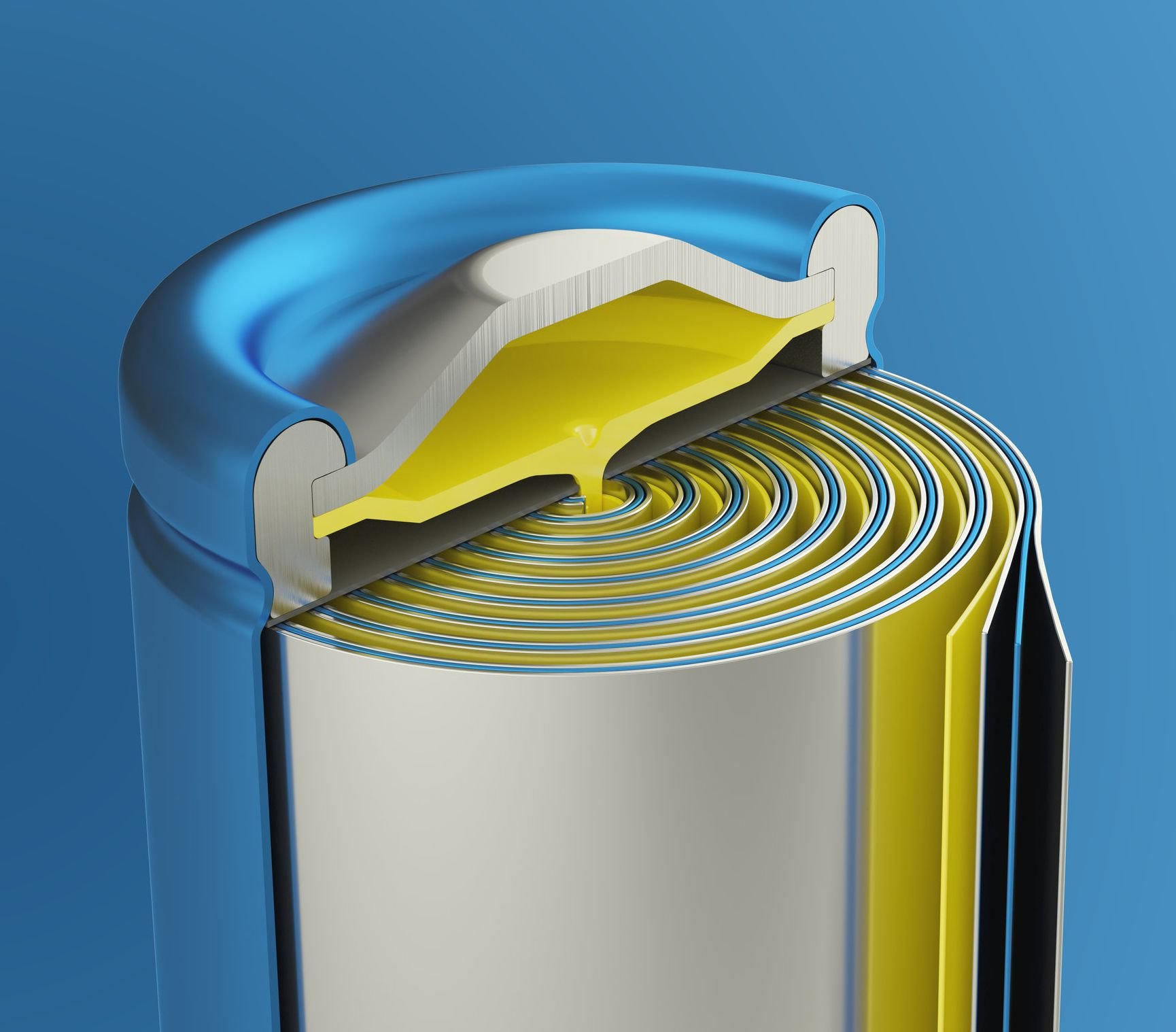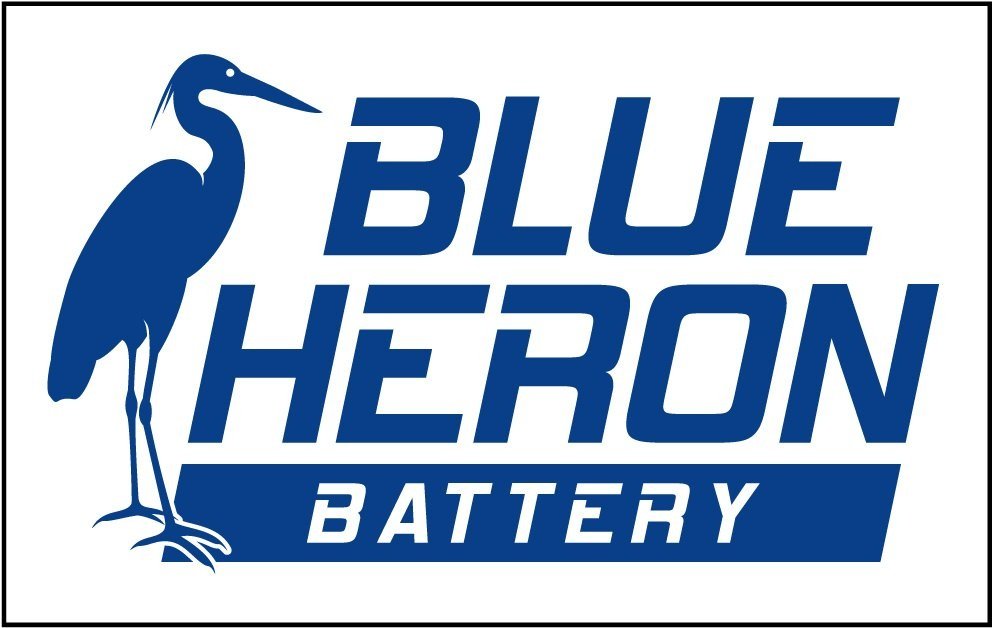
2. Prismatic, Cylindrical, & Pouch cells – Pros and Cons
By the Blue Heron Tech Support Team
Lithium LiFePO4 battery cells basically come in three different arrangements – Prismatic, Cylindrical and Pouch. We will discuss the Pro’s and Con’s of each for our marine, RV or solar battery bank applications.
Prismatic Cells
These are the primary cells Blue Heron uses in its batteries. Prismatic are either fabricated in a polypropylene (often abbreviated PP) case or an aluminum case with PP plastic cap PP is very stiff and resistant to any weather effects such as moisture or salt. Those cells made with an aluminum shell are fabricated with 2024 aluminum. It is inexpensive, widely available, and easily formed. However, it is moderately susceptible to corrosion; so, often manufacturers of such lithium cells in an aluminum shell will place over the shell a thin polyethylene shrink plastic, blue tinted, covering. Over time salt entrained in the air can cause corrosion and breakdown of these shells. Most Lithium battery manufacturers, if they use aluminum shells, will place such cells in a sealed ABS drop-in case. But aluminum shell Lithium cells are not ideal for modular battery banks in a marine environment, or on an RV that may be used in areas close to the coast, as such batteries are expected to serve by many years, up to 10 to 12. And that is a long-time for these low alloy aluminums to stand up to such an environment. Types 5051 or 6062 aluminum are the better material for long term exposure to such environmental conditions, but much more expensive and not selected by manufacturers for that reason
Tests have shown prismatic cells to have a longer life, pack more power in their battery volume, and better support regular deep discharge as compared to cylindrical and pouch cells.[i] And large prismatic cells of a 3.2V size are better able to gain the benefits of BMS cell balancing. Large numbers of cylindrical cells in parallel to form a large amperage cluster are not ideal as one cannot maintain cell to cell balance. Cell balance is critical to lithium batteries to achieve longer cell and battery life. A longer life battery occurs from a single prismatic cell serving as one of four cells in series, with a single BMS to maintain cell balance and battery protection functions. This is why Blue Heron chose to use modular prismatic cells, with four cells in series to form a battery.
Anecdotal information has shown that it is not wise to lay larger prismatic cells on their side in marine applications, as this can lead to internal damage of a cell. Some manufacturers also advise not having lithium cells above a certain size, some saying 200Ah max, while other say 300Ah max. At least two manufacturers of quality prismatic cells have a max cell size of 400Ah, and they are fine with these being placed in a yacht but advise placing vertically (standing up). Several of the manufacturers of high-quality prismatic cells advise placing the batteries in rubber pad to absorb any shock loading from wave action in a boat.
There is also an article in the Press that argues since a prismatic based battery typically has four cells in series and a cylindrical made one has maybe 17 in parallel and four clusters in series with 68 total cells, if a cell goes bad in a prismatic battery one loses a large percentage of voltage, and if a cylindrical cell goes bad there are a large number of other cells available to pick up the load. This is attempting to make a reliability engineering argument, but that argument is without engineering or scientific merit. We discuss this further in an Addendum below.
So, in summary – the Pro’s for a prismatic cell are longer cycle life, deeper discharge capability, and more dense power in the volume used. And, if made with PP shells, no corrosion concerns in marine or near-ocean applications. The Con’s are – prismatic cells are more expensive to fabricate, and if aluminum shelled, do not have good resistance to exposure to corrosive environments if used in an exposed modular cell application. But, as demand has continued to increase for deep cycle battery storage capability, prices for prismatic cells have come down. So Blue Heron is able to offer prismatic cell Drop-In and Modular batteries at attractive prices. And Blue Heron Modular Cell batteries have PP plastic shells for the cells.
Cylindrical Cells –
Cylindrical Lithium cells using LiFePO4 chemistry are in wide use. The individual cylindrical cells are fabricated in automated processes, so they can be made in large quantities and at low prices. These are then arranged in large gangs or ‘clusters’ of parallel cells to reach the desired Amp-Hour rating, and then connected in series to reach the desired voltage level of the battery. Such arrangements are used widely in tools, storage batteries, and automotive and equipment applications. They are arranged in parallel and in series is among the cheapest methods of fabricating a Lithium battery.
Most Lithium batteries being sold for the Marine and the RV industries are made from cylindrical cells. The arrangement and connection of them to be placed in a drop-in battery case is done manually, but usually with automated tools for spot welding. So even batteries fabricated from cylindrical cells are inexpensive to fabricate. That is the principal benefit of these type cells.
While Tesla selected the cylindrical cell for their EV application, that was done for economic price point issues on the overall price of the car, and also due to considerations that EV users were more likely to do only short discharges of their capacity, like driving around locally, in most applications, and only occasionally doing a longer distance, deep discharge run. So, for price-point of the car and for typical use, the cylindrical cell made the most sense. They are expected to last 1,500 cycles, and thus need full battery bank replacement two to three times over the vehicle’s life of 15 years.[ii]
We note that EV battery life using cylindrical cells is substantially extended due to liquid cooling systems to keep battery temperatures down on extended use (driving in their case) and charging routines. We don’t have practical access to such cooling systems for batteries in RV, marine or solar storage applications.
So, what are the mechanisms that keep a cylindrical cell from achieving the full level of cycle life and repeated depth of discharge as prismatic cells, in our marine, RV or solar storage applications? The first factor is cell balancing. Cell balancing is important to keep cells at the same state charge, to ensure long term battery life and safety. Every cell that comes out of manufacturing, even if in the same batch, will be slightly different than the next on in terms or rest voltage, internal resistance, and capacity. Lithium cells are seriously susceptible to degradation from over and undercharging. Cells that have slightly less capacity or differences in internal resistance will receive significantly more or less charge when charging all cells the same with your large charger or your large load. Discrete cell balancing would keep these parameters close from cell to cell when doing large charging or discharging of the battery, but that is not practical with a large number of cylindrical cells.[iii]
With numerous cycles over a battery’s life, there is a cumulative effect on potential degradation of individual cells if over that long life one did not employ discrete cell by cell balancing. Shortened life of these cells will occur, and they will pull down the entire battery yielding shortened battery life. As an example, if 30 Type 26650 LiFePO4 cells are rigged in parallel to give a 100Ah cluster of 3.2V, it is not practical to monitor each of those cells for cell balancing. So, the manufacturer of a 12.8V drop-in battery using 30 of those cells in parallel to form a cluster, and then 4 of those clusters in series to make the 12.8V battery, treats each cluster as if it is a “cell” for BMS purposes. And, “cell” monitoring and balancing of each cluster is provided by the BMS. But that is not true cell balancing of each of the 120 cells in that battery. So shortened cell life and thus battery life occurs due to this less-than-ideal cell balancing. However, these effects occur after many, many cycles. Cylindrical cells still can experience a fairly long life, like 3,000 to 4,000 cycles before they realize the effects of this lack of discrete cell balancing.[iv]
The primary Pro for cylindrical cells is that they are inexpensive to manufacture. The primary Con’s are a shorter life compared to Prismatic, but longer than Pouch cells, and difficulty in achieving optimal cell matching and cell balancing.
Pouch Cells –
The pouch cell places the sheets of anode and cathode material, with separator material, inside a soft-sided pouch, and then sealed after inserting the electrolyte. Because the sides are not restricted, it is possible for materials to swell and gas to form that could rupture the pouch. So, to reduce this potential, manufacturers stack the pouches close together and add some banding and packaging to restrict the potential swelling to only about 10%. They are low cost to produce and allow more discrete sizing of the battery voltage and capacity to meet a client’s needs. A major benefit is the ability to handle a rapid discharge.
The primary Pro’s are – the small size, the lighter weight, and the ability to handle a rapid discharge. The Con’s are - like cylindrical, they do not achieve as long a life, they don’t support extensive deep cycle functions, and they are susceptible to rupture if use is pushed too long.
Addendum – Reliability of Cylindrical vs. Prismatic Based Batteries
The argument that the cylindrical cell-based battery has less impact due to a failed cell does not properly treat the cell’s likely failure modes. The argument is assuming if a prismatic cell “fails” it still has conductivity to the negative terminal of the battery, either directly or through upstream cells. And, it assumes the cell just stops producing electrical current, but maintains that conductivity without any other effect. That does not properly account for lithium cell typical failure modes.
A lithium cell fails most often due to long term use and accumulation of fixed lithium on the anode, held there by crystalline bonding, and no longer able to migrate back to the cathode in charging. Charging and aged cell can only drive a small amount of lithium back to the cathode, and thus the cell has very little capacity. Charging a cell in this condition causes the cell to heat, due to the increased internal resistance. Such a condition is undesirable in a lithium battery as it overheats the cell, adversely affects adjacent cells, and potentially leads to thermal runaway and venting of the electrolyte.
A battery with four cells has only four possible cells that can lead to this situation. A battery made of 28 cells has 28 possible opportunities to get to this condition. And, and a battery with more cells, like 68, has many more opportunities to get to this undesired situation.
In reality we need to be observing the state of our lithium battery cells and the battery’s loss of capacity over time, and removing the battery from use before we get to potential thermal runaway conditions and a serious consequence.
So rather than arguing we can still keep going with a bad cell, we should be careful to remove a lithium battery from service if it has a failed or bad cell. A prismatic based battery has fewer opportunities to get to a failed cell condition, and with discrete cell balancing as noted earlier in this paper, one has better control over cell balance and maintain the health of every cell in the battery.
Our owner’s manual provides extensive information on battery condition monitoring, and our recommendations on triggers to remove the battery from service well before we have loss of a cell. And we provide many steps to take to ensure the long life of your precious lithium cells.
(This technical article is the property of Blue Heron Battery LLC and may not be copied or reprinted in whole or in part without the express permission of Blue Heron Battery LLC.)
———————————————————
[i] “Not All Lithium-Ion Batteries Are Created Equal”, Industry Perspective, Stu Statman, July 15, 2015.
[ii] Tesla battery life, replacement costs, and the solution to EV's biggest challenge (inverse.com)
[iii] Battery Power Online | Why Proper Cell Balancing is Necessary in Battery Packs
[iv] Overview of cell balancing methods for Li‐ion battery technology - S - 2021 - Energy Storage - Wiley Online Library



